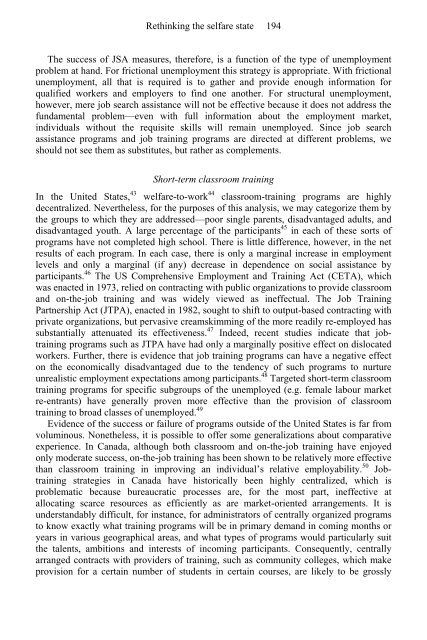Rethinking the Welfare State: The prospects for ... - e-Library
Rethinking the Welfare State: The prospects for ... - e-Library
Rethinking the Welfare State: The prospects for ... - e-Library
You also want an ePaper? Increase the reach of your titles
YUMPU automatically turns print PDFs into web optimized ePapers that Google loves.
<strong>Rethinking</strong> <strong>the</strong> selfare state 194<br />
<strong>The</strong> success of JSA measures, <strong>the</strong>re<strong>for</strong>e, is a function of <strong>the</strong> type of unemployment<br />
problem at hand. For frictional unemployment this strategy is appropriate. With frictional<br />
unemployment, all that is required is to ga<strong>the</strong>r and provide enough in<strong>for</strong>mation <strong>for</strong><br />
qualified workers and employers to find one ano<strong>the</strong>r. For structural unemployment,<br />
however, mere job search assistance will not be effective because it does not address <strong>the</strong><br />
fundamental problem—even with full in<strong>for</strong>mation about <strong>the</strong> employment market,<br />
individuals without <strong>the</strong> requisite skills will remain unemployed. Since job search<br />
assistance programs and job training programs are directed at different problems, we<br />
should not see <strong>the</strong>m as substitutes, but ra<strong>the</strong>r as complements.<br />
Short-term classroom training<br />
In <strong>the</strong> United <strong>State</strong>s, 43 welfare-to-work 44 classroom-training programs are highly<br />
decentralized. Never<strong>the</strong>less, <strong>for</strong> <strong>the</strong> purposes of this analysis, we may categorize <strong>the</strong>m by<br />
<strong>the</strong> groups to which <strong>the</strong>y are addressed—poor single parents, disadvantaged adults, and<br />
disadvantaged youth. A large percentage of <strong>the</strong> participants 45 in each of <strong>the</strong>se sorts of<br />
programs have not completed high school. <strong>The</strong>re is little difference, however, in <strong>the</strong> net<br />
results of each program. In each case, <strong>the</strong>re is only a marginal increase in employment<br />
levels and only a marginal (if any) decrease in dependence on social assistance by<br />
participants. 46 <strong>The</strong> US Comprehensive Employment and Training Act (CETA), which<br />
was enacted in 1973, relied on contracting with public organizations to provide classroom<br />
and on-<strong>the</strong>-job training and was widely viewed as ineffectual. <strong>The</strong> Job Training<br />
Partnership Act (JTPA), enacted in 1982, sought to shift to output-based contracting with<br />
private organizations, but pervasive creamskimming of <strong>the</strong> more readily re-employed has<br />
substantially attenuated its effectiveness. 47 Indeed, recent studies indicate that jobtraining<br />
programs such as JTPA have had only a marginally positive effect on dislocated<br />
workers. Fur<strong>the</strong>r, <strong>the</strong>re is evidence that job training programs can have a negative effect<br />
on <strong>the</strong> economically disadvantaged due to <strong>the</strong> tendency of such programs to nurture<br />
unrealistic employment expectations among participants. 48 Targeted short-term classroom<br />
training programs <strong>for</strong> specific subgroups of <strong>the</strong> unemployed (e.g. female labour market<br />
re-entrants) have generally proven more effective than <strong>the</strong> provision of classroom<br />
training to broad classes of unemployed. 49<br />
Evidence of <strong>the</strong> success or failure of programs outside of <strong>the</strong> United <strong>State</strong>s is far from<br />
voluminous. None<strong>the</strong>less, it is possible to offer some generalizations about comparative<br />
experience. In Canada, although both classroom and on-<strong>the</strong>-job training have enjoyed<br />
only moderate success, on-<strong>the</strong>-job training has been shown to be relatively more effective<br />
than classroom training in improving an individual’s relative employability. 50 Jobtraining<br />
strategies in Canada have historically been highly centralized, which is<br />
problematic because bureaucratic processes are, <strong>for</strong> <strong>the</strong> most part, ineffective at<br />
allocating scarce resources as efficiently as are market-oriented arrangements. It is<br />
understandably difficult, <strong>for</strong> instance, <strong>for</strong> administrators of centrally organized programs<br />
to know exactly what training programs will be in primary demand in coming months or<br />
years in various geographical areas, and what types of programs would particularly suit<br />
<strong>the</strong> talents, ambitions and interests of incoming participants. Consequently, centrally<br />
arranged contracts with providers of training, such as community colleges, which make<br />
provision <strong>for</strong> a certain number of students in certain courses, are likely to be grossly


